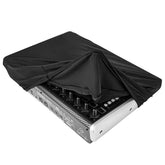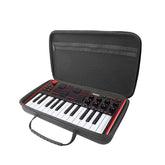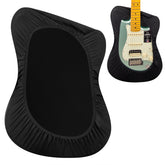Subversion of the Industry! Focusrite fourth generation 2i2 4th Gen detailed
The recent hot topic in the recording equipment circle is undoubtedly the fourth generation Scarlett audio interface by Focusrite. After all, there are not many musicians who haven't used Scarlett. So, anyone can criticize it a bit.
It is the audio interface that receives the most "tribute" from peers.
None of the following audio interfaces are Scarletts.
Speaking of which, both domestic and international review media mostly choose to test the 4i4 (fourth generation). However, we chose the 2i2 (fourth generation) because...
The third-generation 2i2 is our "go-to" audio interface. For many low-intensity tests, we use the 2i2 because it's convenient (USB-powered) and stable (after all, it doesn't have many features), and it has never let us down.
Another option meeting these criteria is the MOTU M2, but the 2i2 is smaller, lighter, and more portable. Additionally, the 2i2 is cheaper, and there are some "behavioral" factors—the bright red chassis, you can always spot it first in a pile of equipment.
So, the purpose of this review is to see if the review room needs to upgrade its personal audio interface.
First, let's take a look at the official video for the fourth generation Scarlett:
Now, let's compare the official specifications.
According to official data, the input dynamic range of the fourth generation 2i2 is 115dB. Following industry conventions, our actual test may be slightly lower than the official parameters, around 114dB.
For example, the previous generation (third generation) 2i2 had an official output dynamic range of 108dB, and our test measured 107.5dB. The result of the actual test is 115.4dB. Therefore, the actual dynamic range should be around 116dB.
Free extra 1dB of dynamic range!!
Note that the second-generation (2i2) test we conducted seven years ago had an actual measurement of 104dB. Therefore, the third-generation 2i2 only increased by 3.5dB, while the fourth generation 2i2 increased by 8dB—squeezing out even more performance!
At the same price ($199 USD), it is at the forefront, only on par with the MOTU M2. However, the 2i2 has lower distortion than the M2, with a measured Total Harmonic Distortion (THD) of only 0.00054%. This data is not "unbelievable" and is on par with interfaces in the six to seven thousand-dollar range, such as the Babyface Pro.
When we linked the output of the Apogee Desktop and tested the input of the 2i2 separately, the measured dynamic range reached a high of 116.6dB. However, at this point, THD distortion increased to 0.00297%, which is slightly high in the same class. The reason is that the gain of the 2i2 cannot be too small. In the initial loop test, the gain was set to +6dB, resulting in extremely low distortion. However, when linked with the Apogee, the gain only needs to be set to +2dB.
So, if you want ultra-low distortion, the gain should be at least set to +6dB (which is acceptable for normal use, right?).
Finally, testing the output of the 2i2 alone, we measured a 119dB output, which matches the official parameter of 120dB.
It's quite nostalgic. When I started reviewing more than a decade ago, one of the definitions of "professional-grade audio interfaces" and "studio-grade audio interfaces" was that the dynamic range should reach 120dB. At that time, only a few interfaces in the twenty-thousand-dollar range could achieve this, and now even thousand-dollar interfaces can do it.
The upgrade of the fourth generation 2i2 is quite aggressive. According to the upgrade scale of the previous three generations, the fourth generation 2i2 should have a talkback button and a 60dB talkback push force, as well as 114dB input/output dynamic range. However, the official decision was to go all the way. The traditionally stable Focusrite has transformed into a "coil king."
Of course, it also increased by $50 USD, but from the above, its cost increase is definitely more than $50 USD. Just the upgrade of the AD/DA chip (from CS4272 to CS5381 + 43198) already raises suspicions of "piling up." There are also many new processes and features that appear for the first time in this price range.
Since Focusrite sets the "industry baseline," now the entire industry is under immense pressure. Not only can the fourth generation 2i2 challenge interfaces at the same $199 price point, but it may even affect the sales of its own Vocaster and Clarett series, potentially harming the enemy more than itself.
Now, the R&D departments of various audio interfaces are either redesigning or considering price reductions.
Coincidentally, the popular Apogee BOOM dropped from $299 to $249 last week.
Of course, since the fourth generation 2i2 has been on the market for a short time, it definitely has some imperfections. Here are some areas we think it might improve in the future:
-
The mobile app for Focusrite Control has not been upgraded to the 2nd generation, so currently, you cannot control the audio interface with your phone.
-
The newly added large knob's LED is too bright at night, and the flashing can easily be distracting, so it would be great if the brightness could be adjusted.
-
The Control 2 software does not display gain values. If you have OCD, you won't know exactly how much gain you have.
-
The Clip Safe feature currently has a bug, and it's a "black box" that can't be adjusted manually. Hopefully, manual settings will be possible in the future.
At this price point, there are certainly some drawbacks. If you plan to go for the 2i2, here are some things to note:
-
The input/output knobs do not have a "notch," although the accuracy is 1dB, it's challenging to precisely increase/decrease by 1dB.
-
The headphone amp gain (+10dBu) is relatively small in the same class, so it is recommended to use low-impedance headphones below 100Ω.
-
Note that the Scarlett Solo has only +57dB of talkback push force and a single USB-C design (not compatible with mobile devices). It may be more suitable for audiophiles (120dB output). Therefore, for live streaming and recording, we recommend going straight to the 2i2 or 4i4.






